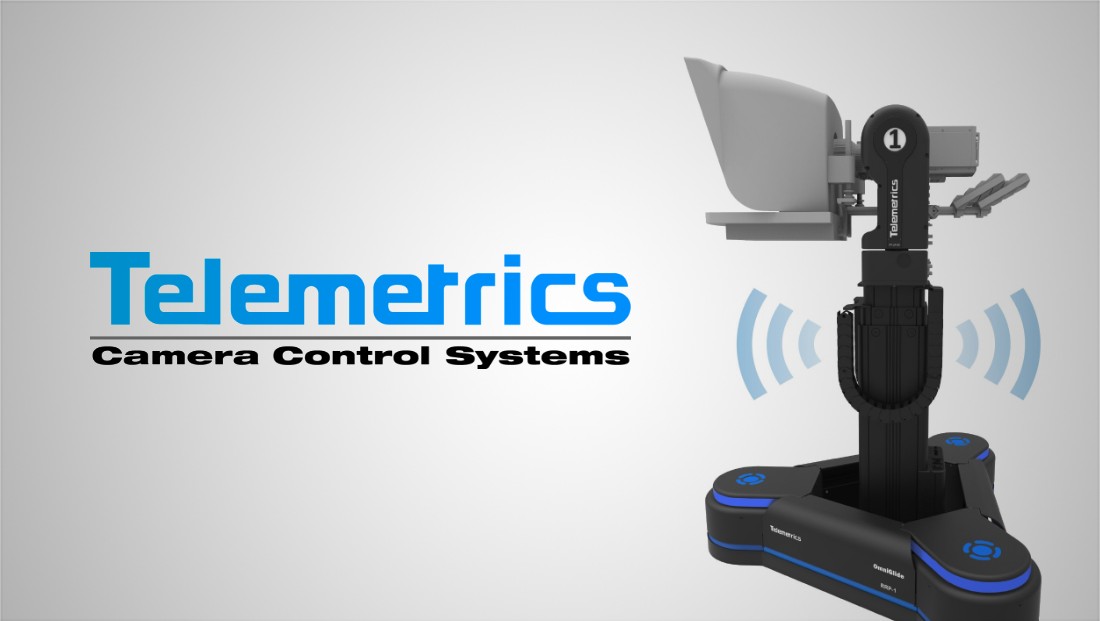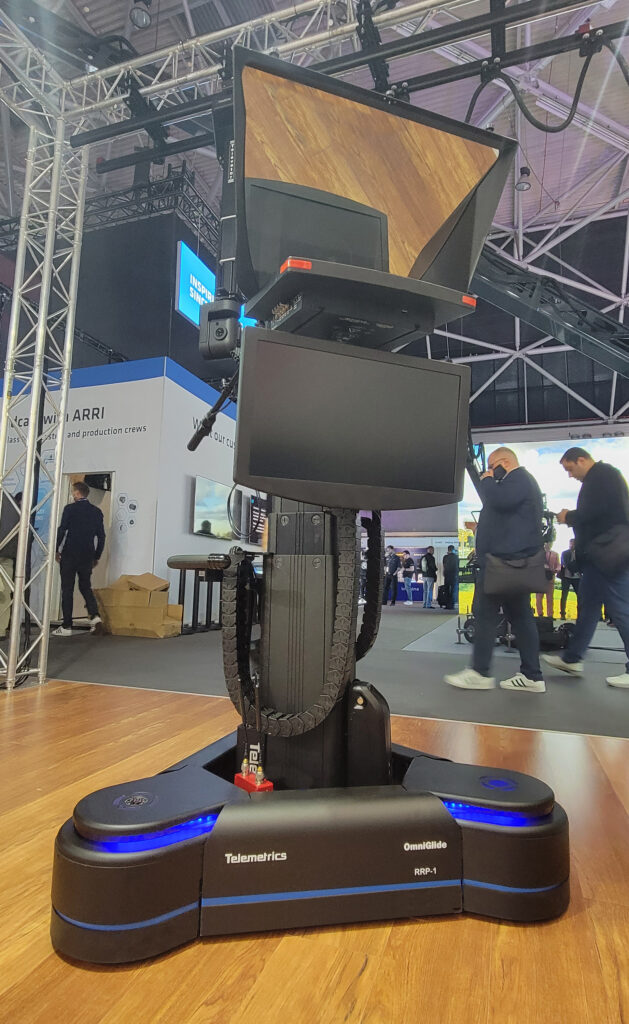Telemetrics reaches new milestone with wireless studio camera pedestal

Subscribe to NewscastStudio for the latest news, project case studies and product announcements in broadcast technology, creative design and engineering delivered to your inbox.
Camera robotics specialist Telemetrics has developed a new modular battery system for its OmniGlide Robotic Roving Platform that allows users to power an on-board wireless video transmitter and freely move the popular OmniGlide studio camera pedestal and avoid obstacles virtually anywhere in the studio without cables.
Using proven and mature wireless transmissions to operate a studio rover has never been done before, although it has been on many production professionals’ wish lists for some time. The ground-breaking wireless studio camera system was named a “Best Of Show” product at the recent IBC 2022 Show.
The new option for the OmniGlide consists of a field-proven wireless transmitter and battery system configured to the rover’s specifications while maintaining the rover’s esthetics and precise, preprogrammed or manual movements. The wireless transmitter’s low latency (sub frame delay of 7 milliseconds) ensures the reliability of exact pedestal movements. The lithium-ion battery system provides DC power—which is safer than running AC power, as most rovers do* Users can shoot a production all day on battery power and then charge it overnight to be ready for the next project.
* The European Union has mandated that populated spaces, such as production studios, must use low voltage (DC) power as a health and safety issue.
Going wireless with the rover still provides the same functionality customers are used to including camera power and control, teleprompter power and video, confidence monitor power and video and full robotic control. Also, at any time, the system can run on a standard cable loop providing a full backup solution. The wireless system is designed so that all OmniGlides currently in the field can be upgraded to wireless operation.

The wireless OmniGlide was awarded a “Best Of Show” award at the 2022 IBC show.
NewscastStudio spoke with Michael Cuomo, Vice President, Telemetrics, Inc., to discuss how the wireless studio camera system will change the way operators creatively move their cameras in the studio while gaining access to a variety of new operational features that promote pre-determined automated movements.
Why is a wireless studio pedestal (rover) so important?
Mobility and creative freedom are two clear benefits, along with eliminating the cables that have vexed customers since robotic rovers started being used in production studios. We are the first robotic camera control systems company to bring it to market because new technologies like artificial intelligence (AI) and wireless transmission are now mature enough to work reliably in a live production environment.
While a wireless transmitter is used for the control and video signals from the camera, the DC-powered system developed by Telemetrics for the OmniGlide Robotic Roving Platform is equally as important.
With the rover we can use multiple batteries that are hot swappable, allowing for continuous 24/7 run time. The Lithium Ion batteries are very cheap, fully rechargeable and can be swapped out as required without having to power down the rover system.
We’re using several off-the-shelf battery modules enclosed in a special housing that are also used to power other wireless systems (like an e-Bike) that fit snuggly into the rover’s base. All of the charging is performed off the rover at a charging station, which supports staff and rover system safety.
Why hasn’t this been done before?
The wireless rover becomes a much more important feature for customers as the rover gets more advanced. With the OmniGlide, we’re now doing Path Planning, which provides the ability for multiple rovers to communicate with each other and see where they are in the studio space as they navigate around set pieces and avoid people.
Based on these and other features, the wireless option for the rover now moves the product into areas that where it didn’t move before and allows it to be used more creatively in a live production environment. That’s why a wireless roving studio pedestal has now become so important. Because when you want to do all of these new things and take advantage of the new features (moving to new areas of the studio, avoid set pieces, etc.), and you also have to worry about the cable getting caught on something, or getting tangled with another rover in the studio, it limits the benefits of these new features.
We see the wireless rover as the enabler that allows us as a manufacturer to offer advanced features—like Path Planning, automated studio moves with Studio View, and talent tracking with our AI-assisted reFrame Automated Shot correction software—that customers can quickly implement into their studios.
Will this technology be widely embraced?
One of the big pain points for customers using rovers in the cable. With our control panel, we know where the rover is, but you don’t know where the cable is. And the cable is never long enough to do what you’d like to do without stopping and resetting the rover position. Studios typically have a person dedicated to managing the cables and making sure they do not get tangled. This is really the next evolution in roving pedestals and we’re happy to offer it first.
Is WiFi interference an issue for studios that might have a lot of wireless devices being used?
We were able to demonstrate the wireless rover system at the recent IBC show in Amsterdam, in a convention building that was full of wireless devices being operated, and it worked perfectly. A typical studio would not have that amount of RF traffic and would certainly not have to travel far from the control panel. So, we’re confident that it will perform well in any studio environment.
Do you plan on bringing this technology to other products in your portfolio?
Yes. We are now looking to migrate this wireless technology to our TeleGlide track systems as well, enabling a camera trolley to move freely along a track without the fear of tangled cables. Because a lot of the same benefits you get with a wireless rover you also get with track systems. You no longer need to have large cable loops in ceiling installations or on the floor, where you have to someone to manage the cables as the trolley moves along. Removing the cable becomes a huge benefit.
Learn more about Telemetrics and its broadcast expertise on its website.
The above column is sponsor-generated content from Telemetrics. To learn more about sponsor-generated content, click here.
Subscribe to NewscastStudio for the latest news, project case studies and product announcements in broadcast technology, creative design and engineering delivered to your inbox.



tags
Michael Cuomo, robotic cameras, Telemetrics, Telemetrics OmniGlide, Telemetrics OmniGlide Roving Platform
categories
Partner Content